英语介词知识点大全
- 格式:doc
- 大小:98.50 KB
- 文档页数:6
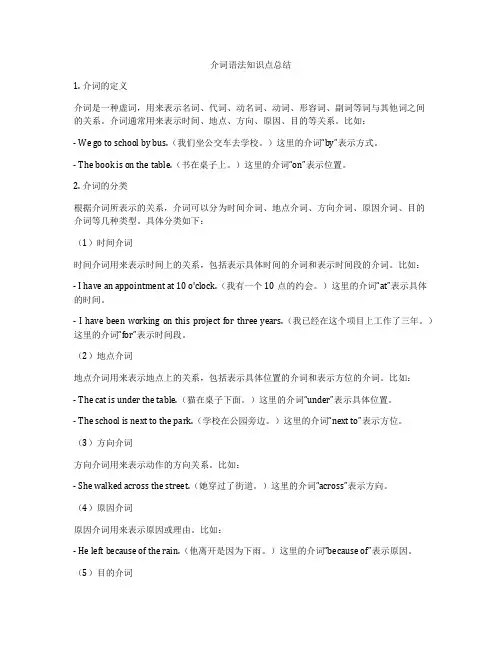
介词语法知识点总结1. 介词的定义介词是一种虚词,用来表示名词、代词、动名词、动词、形容词、副词等词与其他词之间的关系。
介词通常用来表示时间、地点、方向、原因、目的等关系。
比如:- We go to school by bus.(我们坐公交车去学校。
)这里的介词“by”表示方式。
- The book is on the table.(书在桌子上。
)这里的介词“on”表示位置。
2. 介词的分类根据介词所表示的关系,介词可以分为时间介词、地点介词、方向介词、原因介词、目的介词等几种类型。
具体分类如下:(1)时间介词时间介词用来表示时间上的关系,包括表示具体时间的介词和表示时间段的介词。
比如:- I have an appointment at 10 o'clock.(我有一个10点的约会。
)这里的介词“at”表示具体的时间。
- I have been working on this project for three years.(我已经在这个项目上工作了三年。
)这里的介词“for”表示时间段。
(2)地点介词地点介词用来表示地点上的关系,包括表示具体位置的介词和表示方位的介词。
比如:- The cat is under the table.(猫在桌子下面。
)这里的介词“under”表示具体位置。
- The school is next to the park.(学校在公园旁边。
)这里的介词“next to”表示方位。
(3)方向介词方向介词用来表示动作的方向关系。
比如:- She walked across the street.(她穿过了街道。
)这里的介词“across”表示方向。
(4)原因介词原因介词用来表示原因或理由。
比如:- He left because of the rain.(他离开是因为下雨。
)这里的介词“because of”表示原因。
(5)目的介词目的介词用来表示目的或目标。
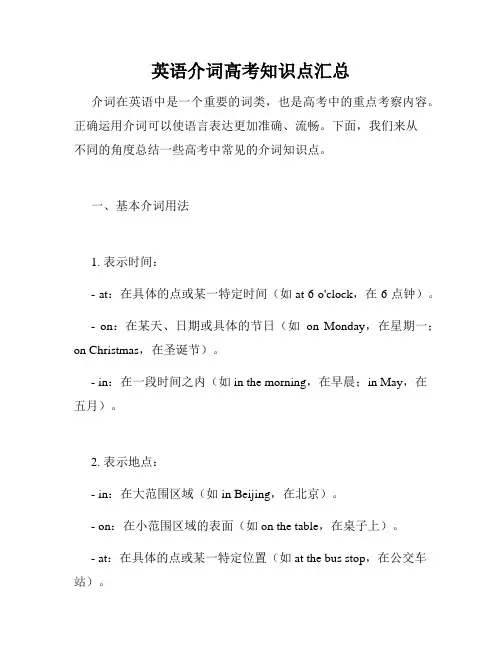
英语介词高考知识点汇总介词在英语中是一个重要的词类,也是高考中的重点考察内容。
正确运用介词可以使语言表达更加准确、流畅。
下面,我们来从不同的角度总结一些高考中常见的介词知识点。
一、基本介词用法1. 表示时间:- at:在具体的点或某一特定时间(如at 6 o'clock,在 6 点钟)。
- on:在某天、日期或具体的节日(如on Monday,在星期一;on Christmas,在圣诞节)。
- in:在一段时间之内(如in the morning,在早晨;in May,在五月)。
2. 表示地点:- in:在大范围区域(如in Beijing,在北京)。
- on:在小范围区域的表面(如on the table,在桌子上)。
- at:在具体的点或某一特定位置(如at the bus stop,在公交车站)。
3. 表示方式、原因、目的等:- for:表示对某人或某事有利(如good for health,有益于健康)。
- by:通过某种方式或手段(如by bus,乘坐公交车;by the way,顺便说一下)。
- with:伴随某物或某人一起(如play with friends,和朋友一起玩)。
4. 表示动作的方向或位置:- to:表示朝着某处(如go to school,去学校)。
- from:表示从某处来(如come from China,从中国来)。
- into:表示进入某处(如go into the room,进入房间)。
5. 表示从属关系:- of:表示所属关系(如a friend of mine,我的一个朋友)。
二、固定搭配1. look forward to:期待- I'm looking forward to the summer vacation.(我期待着暑假的到来。
)2. be fond of:喜欢- She is fond of playing basketball.(她喜欢打篮球。
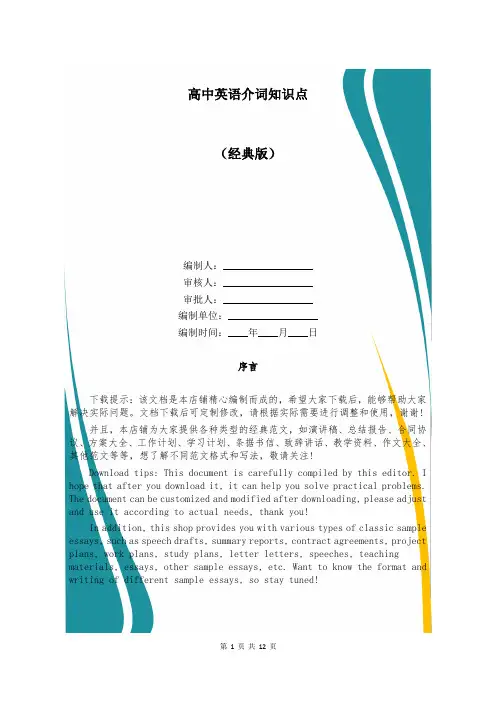
高中英语介词知识点(经典版)编制人:__________________审核人:__________________审批人:__________________编制单位:__________________编制时间:____年____月____日序言下载提示:该文档是本店铺精心编制而成的,希望大家下载后,能够帮助大家解决实际问题。
文档下载后可定制修改,请根据实际需要进行调整和使用,谢谢!并且,本店铺为大家提供各种类型的经典范文,如演讲稿、总结报告、合同协议、方案大全、工作计划、学习计划、条据书信、致辞讲话、教学资料、作文大全、其他范文等等,想了解不同范文格式和写法,敬请关注!Download tips: This document is carefully compiled by this editor. I hope that after you download it, it can help you solve practical problems. The document can be customized and modified after downloading, please adjust and use it according to actual needs, thank you!In addition, this shop provides you with various types of classic sample essays, such as speech drafts, summary reports, contract agreements, project plans, work plans, study plans, letter letters, speeches, teaching materials, essays, other sample essays, etc. Want to know the format and writing of different sample essays, so stay tuned!高中英语介词知识点介词的英语全称为“preposition”是由“前缀pre-(在……前部)+position(位置)”构成的,所以又叫前置词。

初中英语知识点归纳介词的用法介词是连接词与词之间,短语与短语之间,在句中表示方向、关系、时间、原因等意义的词语。
在英语中,介词的用法非常丰富多样,掌握好介词的用法,对于学习英语有着重要的意义。
下面将对初中英语中常见的介词用法进行归纳介绍。
一、表示方向、位置和距离的介词1. 在(in):在某个地方或物体内部2. 在(on):在某个平面或表面上3. 在(at):在某个地点4. 在(over):位于之上,不接触5. 在(under):位于之下,不接触6. 在(between):在两个事物之间7. 在(behind):在某物之后8. 在(in front of):在某物之前9. 在(near):在附近10. 在(around):在周围二、表示时间的介词1. 在(at):在某个具体时间点2. 在(in):在某个时间段3. 在(on):在某个具体日期三、表示原因的介词1. 因为(of):表示原因、缘故2. 由于(because of):表示原因、由于四、表示目的、用途和方式的介词1. 为了(in order to):表示目的2. 以便(in order that):表示目的3. 用(with):表示使用的手段或工具4. 通过(by):表示方式、方法5. 以(for):表示目的五、表示比较的介词1. 比较起见(than):表示比较的对象2. 和(with):与某人或某物在一起六、其它常见的介词1. 关于(about):表示涉及某一话题2. 靠(by):表示接近某人或某物3. 经过(through):表示通过某地或某事4. 编写(at):表示在某地工作或活动5. 因(as):表示角色、身份6. 例如(for example):表示举例7. 包括(including):表示包含某物以上是初中英语中常见的介词用法的归纳总结。
熟练掌握这些介词的用法,对于构建正确的句子和语法结构非常重要。
希望能对你的学习有所帮助。
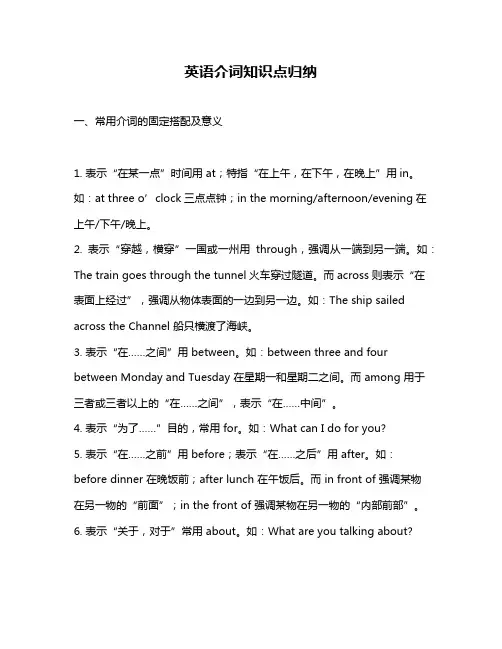
英语介词知识点归纳一、常用介词的固定搭配及意义1. 表示“在某一点”时间用 at;特指“在上午,在下午,在晚上”用in。
如:at three o’clock三点点钟;in the morning/afternoon/evening在上午/下午/晚上。
2. 表示“穿越,横穿”一国或一州用through,强调从一端到另一端。
如:The train goes through the tunnel火车穿过隧道。
而across则表示“在表面上经过”,强调从物体表面的一边到另一边。
如:The ship sailed across the Channel 船只横渡了海峡。
3. 表示“在……之间”用 between。
如:between three and four between Monday and Tuesday 在星期一和星期二之间。
而 among 用于三者或三者以上的“在……之间”,表示“在……中间”。
4. 表示“为了……”目的,常用 for。
如:What can I do for you?5. 表示“在……之前”用 before;表示“在……之后”用 after。
如:before dinner 在晚饭前;after lunch 在午饭后。
而 in front of 强调某物在另一物的“前面”;in the front of 强调某物在另一物的“内部前部”。
6. 表示“关于,对于”常用 about。
如:What are you talking about?7. 表示“除了……之外”用 except 或 besides。
如:All are here except Tom./ Besides you, I also know the answer.8. 表示“一个接一个,连续地”用 in turn。
如:They took the presents in turn.9. 表示“自……至……用from…to…” 如:from Monday to Friday 从星期一到星期五10. 表示“一方面的……另一方面……”常用 on one hand, on the other hand”。

英语介词知识点归纳1. In: 用于表示在一些位置或范围内。
例如:in the park, in the house.2. On: 用于表示在一些表面上。
例如:on the table, on the wall.3. At: 用于表示在一些地点。
例如:at the bus stop, at the park.5. To: 表示目的地。
例如:to the beach, to the park.6. By: 表示交通工具或方式。
例如:by train, by bus.7. With: 表示伴随或使用。
例如:with my friend, with a pen.8. For: 表示目的或用途。
例如:for a party, for studying.9. About: 表示关于一些主题。
例如:about the movie, about the book.10. Over: 表示在一些区域上方。
例如:over the bridge, overthe sky.11. Under: 表示在一些区域下方。
例如:under the table, under the bed.12. Through: 穿过一些空间或经历一些过程。
例如:through the door, through the forest.13. Withou: 表示没有一些东西或情况。
例如:without a hat, without a doubt.14. Above: 表示在物之上。
例如:above the clouds, above the sign.15. Below: 表示在物之下。
例如:below the surface, below the line.。
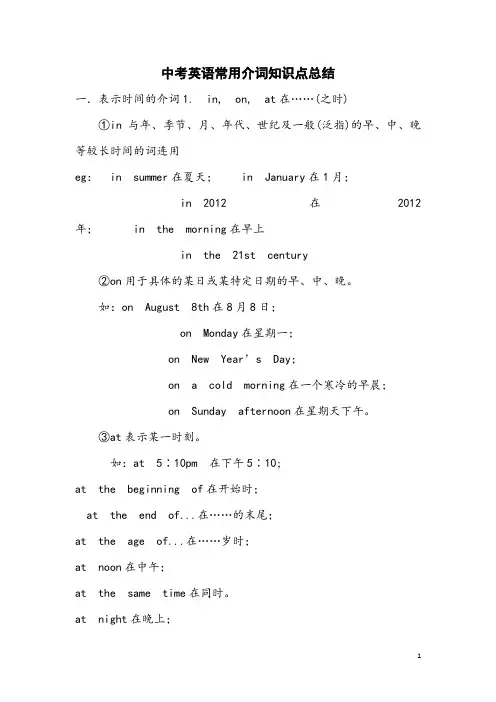
中考英语常用介词知识点总结一.表示时间的介词1. in, on, at在……(之时)①in与年、季节、月、年代、世纪及一般(泛指)的早、中、晚等较长时间的词连用eg:in summer在夏天;in January在1月;in 2012 在2012年;in the morning在早上in the 21st century②on用于具体的某日或某特定日期的早、中、晚。
如:on August 8th在8月8日;on Monday在星期一;on New Year’s Day;on a cold morning在一个寒冷的早晨;on Sunday afternoon在星期天下午。
③at表示某一时刻。
如:at 5∶10pm 在下午5∶10;at the beginning of在开始时;at the end of...在……的末尾;at the age of...在……岁时;at noon在中午;at the same time在同时。
at night在晚上;2. in, after 在……之后“in +时间段”用于将来时之中;“after+时间段”用于过去时态之中;“after+时间点”既可用于将来时也可用于过去时。
如:Jim will go to Beijing in five days.吉姆五天后会去北京。
Jim went to Beijing after five days.五天后,吉姆去了北京。
Jim will go to Beijing after five o’clock.吉姆会在五点钟后去北京。
3. for, sincefor可以指过去、现在或将来,着重说明“多久”,后面接时间段。
since意为“自从……起”,多与完成时连用,后面接时间点或从句。
since引导的从句通常为一般过去时。
如:He has lived here for 2 weeks./ He has lived here since 2 weeks ago.It’s five years since he left school.4. after, behind 在……之后after主要用于表示时间;behind主要用于表示位置。

介词连词知识点总结归纳一、介词的基本概念介词(Prepositions)是一种词类,它通常用来连接名词、代词、动名词或从句等成分,表示时间、地点、方向、原因、目的等关系。
英语中常见的介词有:on, in, at, to, for, with, by, from, into, out of, between, among, through等。
1. 表示时间关系的介词on:表示某一天、日期、时间点等。
in:表示较长的时间段,季节、年代等。
at:表示具体的时间点、场所、节日等。
例句:I will meet you at the corner of the street at 3 o'clock.I was born in 1990.She always goes to school on foot.2. 表示地点关系的介词in:表示某个大的范围或容器内。
on:表示某个平面或表面上。
at:表示某个具体点或目标。
例句:The book is in the drawer.There is a cat on the roof.She is waiting at the bus stop.3. 表示方向关系的介词to:表示朝着某个目标或方向。
from:表示从某个地点或方向出发。
into:表示朝着某个范围或内部。
例句:He walked to the park.I come from China.She poured the water into the glass.4. 表示原因和目的的介词for:表示给予或用于某种目的。
with:表示陪伴或使用某种手段。
例句:I bought a gift for my friend.She cut the cake with a knife.5. 表示关系的介词between:表示在两者或多者之间的关系。
among:表示在多个之中的关系。
through:表示穿过或通过某个范围。
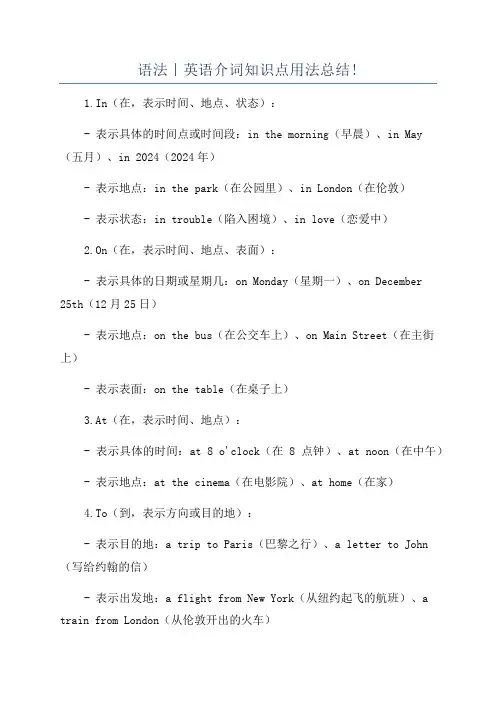
语法|英语介词知识点用法总结!1.In(在,表示时间、地点、状态):- 表示具体的时间点或时间段:in the morning(早晨)、in May(五月)、in 2024(2024年)- 表示地点:in the park(在公园里)、in London(在伦敦)- 表示状态:in trouble(陷入困境)、in love(恋爱中)2.On(在,表示时间、地点、表面):- 表示具体的日期或星期几:on Monday(星期一)、on December25th(12月25日)- 表示地点:on the bus(在公交车上)、on Main Street(在主街上)- 表示表面:on the table(在桌子上)3.At(在,表示时间、地点):- 表示具体的时间:at 8 o'clock(在8点钟)、at noon(在中午)- 表示地点:at the cinema(在电影院)、at home(在家)4.To(到,表示方向或目的地):- 表示目的地:a trip to Paris(巴黎之行)、a letter to John (写给约翰的信)- 表示出发地:a flight from New York(从纽约起飞的航班)、a train from London(从伦敦开出的火车)- 表示原因:suffer from a cold(患感冒)6. For(为了,表示目的、受益人):- 表示目的:study for the exam(为考试而学习)、buy flowers for my mother(给母亲买花)- 表示受益人:a gift for you(给你的礼物)7. With(和,表示伴随、使用、具备):- 表示伴随:go shopping with friends(和朋友一起购物)、have dinner with family(和家人一起吃晚饭)- 表示使用:write with a pen(用钢笔写)- 表示具备:a girl with long hair(一位长发的女孩)以上是一些常见的英语介词及其用法总结,介词在句子中使用灵活多样,需要根据具体语境来选择适当的介词。
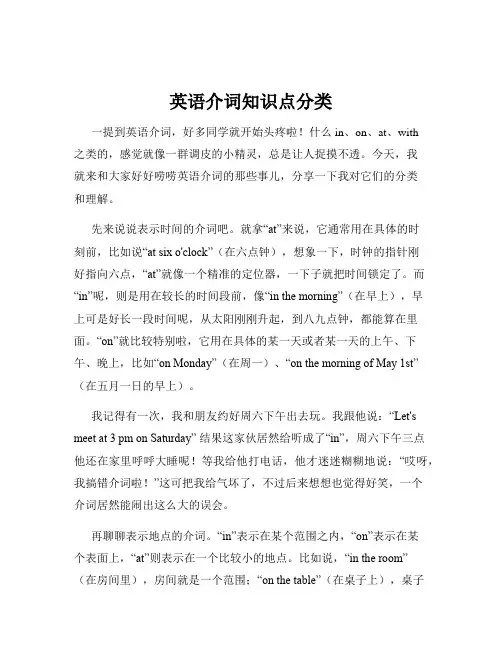
英语介词知识点分类一提到英语介词,好多同学就开始头疼啦!什么 in、on、at、with之类的,感觉就像一群调皮的小精灵,总是让人捉摸不透。
今天,我就来和大家好好唠唠英语介词的那些事儿,分享一下我对它们的分类和理解。
先来说说表示时间的介词吧。
就拿“at”来说,它通常用在具体的时刻前,比如说“at six o'clock”(在六点钟),想象一下,时钟的指针刚好指向六点,“at”就像一个精准的定位器,一下子就把时间锁定了。
而“in”呢,则是用在较长的时间段前,像“in the morning”(在早上),早上可是好长一段时间呢,从太阳刚刚升起,到八九点钟,都能算在里面。
“on”就比较特别啦,它用在具体的某一天或者某一天的上午、下午、晚上,比如“on Monday”(在周一)、“on the morning of May 1st”(在五月一日的早上)。
我记得有一次,我和朋友约好周六下午出去玩。
我跟他说:“Let's meet at 3 pm on Saturday” 结果这家伙居然给听成了“in”,周六下午三点他还在家里呼呼大睡呢!等我给他打电话,他才迷迷糊糊地说:“哎呀,我搞错介词啦!”这可把我给气坏了,不过后来想想也觉得好笑,一个介词居然能闹出这么大的误会。
再聊聊表示地点的介词。
“in”表示在某个范围之内,“on”表示在某个表面上,“at”则表示在一个比较小的地点。
比如说,“in the room”(在房间里),房间就是一个范围;“on the table”(在桌子上),桌子的表面就是我们关注的地方;“at the bus stop”(在公交车站),公交车站相对来说就是一个比较小的具体地点。
我曾经去一个朋友家做客,他家的房子可大了。
我进门的时候说:“Wow, your house is so big I'm in a wonderland!” 然后我把包放在了桌子上,说:“I'll put my bag on the table” 后来我们一起出门,在小区门口等出租车,我就说:“Let's wait for the taxi at the gate of the community”这一连串的“in”“on”“at”,用得那叫一个顺溜,朋友还夸我英语进步了不少呢!还有表示方式、手段的介词,像“by”“with”“in”。
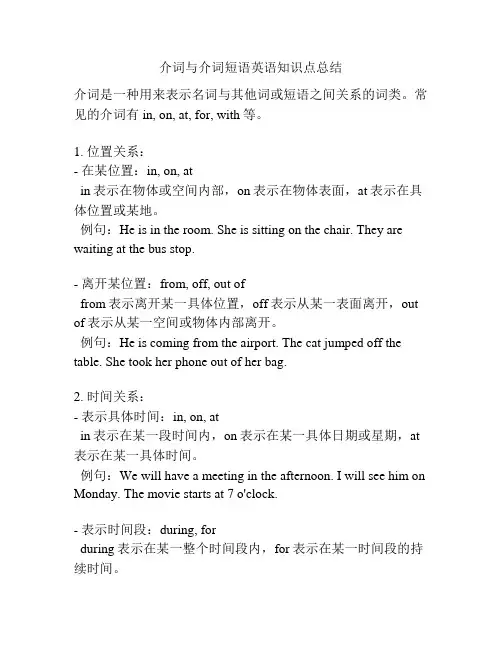
介词与介词短语英语知识点总结介词是一种用来表示名词与其他词或短语之间关系的词类。
常见的介词有in, on, at, for, with等。
1. 位置关系:- 在某位置:in, on, atin表示在物体或空间内部,on表示在物体表面,at表示在具体位置或某地。
例句:He is in the room. She is sitting on the chair. They are waiting at the bus stop.- 离开某位置:from, off, out offrom表示离开某一具体位置,off表示从某一表面离开,out of表示从某一空间或物体内部离开。
例句:He is coming from the airport. The cat jumped off the table. She took her phone out of her bag.2. 时间关系:- 表示具体时间:in, on, atin表示在某一段时间内,on表示在某一具体日期或星期,at 表示在某一具体时间。
例句:We will have a meeting in the afternoon. I will see him on Monday. The movie starts at 7 o'clock.- 表示时间段:during, forduring表示在某一整个时间段内,for表示在某一时间段的持续时间。
例句:He slept during the night. I will stay here for a week.3. 关系连接:- 表示原因:because of, due tobecause of表示由于,due to表示由于(正式用语)。
例句:He couldn't come because of the rain. The event was canceled due to bad weather.- 表示目的:for, tofor表示为了某一目的,to表示向某一目的地或对象。
介词知识点总结文库一、介词的定义和分类1. 介词的定义介词是英语语法中一种虚词,用来表达名词、代词、动词或其他句子成分之间的关系。
介词通常用在名词、代词或动词前,表示它们之间的位置、方向、时间、原因、目的等关系。
2. 介词的分类介词可以根据其使用对象和含义进行分类。
根据使用对象可分为名词性介词和形容词性介词;根据含义可分为时间介词、地点介词、方向介词、原因介词、目的介词等。
二、介词的用法1. 介词与名词的搭配介词通常与名词或代词搭配使用,表达它们之间的关系。
例如:at school, in the park, on the table等。
2. 介词与动词的搭配介词也可以与动词搭配使用,构成动词短语,表示动作或状态的位置、方向等。
例如:look at, listen to, talk about等。
3. 介词短语介词短语是由介词加上名词、代词或动词构成的固定搭配,它可以作状语、定语或补语等。
例如:in the morning, on the table, for her等。
4. 介词的常见错误在英语学习中,介词的用法是一个常见的错误点。
例如:常见的错误包括介词的误用、介词搭配的错误、介词的遗漏等。
三、常见介词1. 时间介词时间介词表示时间的关系,常见的时间介词有:at, in, on, for, since, by, until等。
2. 地点介词地点介词表示位置的关系,常见的地点介词有:in, on, at, under, over, between, among等。
3. 方向介词方向介词表示方向的关系,常见的方向介词有:to, from, into, out of, through, across等。
4. 原因介词原因介词表示原因的关系,常见的原因介词有:because of, due to, owing to等。
5. 目的介词目的介词表示目的的关系,常见的目的介词有:for, to, in order to, so as to等。
介词知识点总结介词是英语中用来表示名词、代词或名词短语与其他词之间关系的词。
它们通常位于名词之前,起到连接和说明作用。
掌握介词的用法对于理解和使用英语至关重要。
以下是一些常见介词的知识点总结:1. 表示位置关系的介词:- 在...里:in (e.g., in the room)- 在...上:on (e.g., on the table)- 在...下:under (e.g., under the bed)- 在...旁边:next to (e.g., next to the door)- 在...对面:opposite (e.g., opposite the bank)2. 表示时间关系的介词:- 在...时:at (e.g., at 5 o'clock)- 在...之前:before (e.g., before the exam)- 在...之后:after (e.g., after dinner)- 从...到...:from...to... (e.g., from Monday to Friday)3. 表示方向的介词:- 向...:to (e.g., go to the school)- 从...:from (e.g., come from China)- 通过...:through (e.g., through the forest)4. 表示方式和手段的介词:- 通过...:by (e.g., by bus)- 用...:with (e.g., with a pen)- 没有...:without (e.g., without a doubt)5. 表示原因和理由的介词:- 因为...:because of (e.g., because of the rain)- 由于...:due to (e.g., due to the weather)- 为了...:for (e.g., for safety reasons)6. 固定搭配中的介词使用:- 介词 + 名词的搭配:e.g., in charge (负责), at risk (冒险), on purpose (故意)- 动词 + 介词的搭配:e.g., look after (照顾), wait for (等待), rely on (依赖)7. 特殊用法:- 某些动词后需要特定的介词,如:spend (on) (花费), think about (考虑), dream of (梦想)- 某些形容词后也需要特定的介词,如:good at (擅长), interested in (对...感兴趣), responsible for (负责)掌握这些基本的介词用法,可以帮助学习者更准确地表达自己的意思,并理解他人的表达。
英语十大介词介绍介词是英语中常用的词类之一,用来表示名词与其他词或词组之间的关系。
在英语中,有很多常用的介词,下面是对英语十大常用介词的简要介绍:1. in:表示在某个地方或某个时间内,例如 "in the park"(在公园里),"in the morning"(在早晨)。
in:表示在某个地方或某个时间内,例如 "in the park"(在公园里),"in the morning"(在早晨)。
2. on:表示在某个表面上或某个具体的日子,例如 "on the table"(在桌子上),"on Monday"(在星期一)。
on:表示在某个表面上或某个具体的日子,例如 "on the table"(在桌子上),"on Monday"(在星期一)。
3. at:表示在某个地点或某个时间点,例如 "at the bookstore"(在书店里),"at 6 o'clock"(在六点钟)。
at:表示在某个地点或某个时间点,例如 "at the bookstore"(在书店里),"at 6 o'clock"(在六点钟)。
4. by:表示通过某种方式或由某人完成,例如 "by train"(乘坐火车),"written by John"(由约翰写的)。
by:表示通过某种方式或由某人完成,例如 "by train"(乘坐火车),"written by John"(由约翰写的)。
5. for:表示为某个目的或时间段,例如 "for studying"(为了研究),"for two hours"(两个小时)。
初中英语知识点归纳常用的介词和介词短语介词是一种连接词,位于句子中,可以表达位置、方向、时间、原因、目的等含义。
在英语学习中,熟练掌握常用的介词和介词短语是非常重要的。
本文将对初中英语中常用的介词和介词短语进行归纳总结,帮助读者更好地理解和运用。
一、位置和方向类介词1. in :表示在某个具体空间或范围内e.g. in the room(在房间里)2. on :表示在某个平面或垂直面上e.g. on the table(在桌子上)3. at :表示在某个位置或地点e.g. at the park(在公园)4. under :表示在某物体的下方e.g. under the chair(在椅子下面)5. above :表示在某物体的上方e.g. above the clouds(在云层上)6. behind :表示在某物体的后方e.g. behind the door(在门后面)7. in front of :表示在某物体的前方e.g. in front of the building(在建筑物前面)二、时间类介词1. at :表示具体的时间点e.g. at 8 o'clock(在8点钟)2. on :表示在某一天或日期e.g. on Monday(在星期一)3. in :表示在某一段时间或月份e.g. in the morning(在早上)4. after :表示在某个时间之后e.g. after school(放学后)5. before :表示在某个时间之前e.g. before dinner(晚饭前)三、原因和目的类介词1. because of :表示由于某个原因e.g. He couldn't come because of the bad weather.(因为天气不好,他不能来。
)2. thanks to :表示由于某个好事发生e.g. Thanks to his help, I passed the exam.(多亏了他的帮助,我通过了考试。
高中英语知识点归纳介词的用法与搭配高中英语知识点归纳:介词的用法与搭配介词在英语中起到连接词或短语之间关系的作用。
熟练掌握介词的用法与搭配对于理解和运用英语语法和表达非常重要。
下面是对高中英语中常用介词的用法与搭配进行归纳总结。
一、介词的基本用法1. of:表示所属关系、来源、构成等。
- The book of John is on the table.(约翰的书在桌子上。
)- The Statue of Liberty was a gift from France.(自由女神像是法国赠送的。
)2. in:表示位置、时间、状态等。
- He is in the room.(他在房间里。
)- I will see you in an hour.(我一个小时后会见你。
)3. to:表示目标、方向等。
- She went to the library to borrow some books.(她去图书馆借书。
) - Please give this letter to him.(请把这封信交给他。
)4. at:表示位置、时间等。
- We will meet at the park.(我们将在公园见面。
)- I have a meeting at 9 o'clock.(我9点有个会议。
)5. for:表示目的、原因等。
- I bought a gift for my friend's birthday.(我为我朋友的生日买了一份礼物。
)- He apologized for being late.(他为迟到而道歉。
)二、介词与名词的常见搭配1. on:- on the table(在桌子上)- on Monday(在星期一)2. in:- in the room(在房间里)- in the morning(在早上)3. at:- at the park(在公园)- at the party(在聚会上)4. to:- go to school(去上学)- talk to the teacher(和老师交谈)5. for:- a gift for her(给她的礼物)- thanks for your help(感谢你的帮助)三、介词与动词的常见搭配1. look at:看- He looked at the picture on the wall.(他看着墙上的画。
常用介词用法总结介词是英语中重要的词类之一,用来表达名词与其他词之间的关系。
掌握常用介词的用法对于提高英语写作水平和交流能力非常有帮助。
本文将总结常用介词的用法,并给出相关例句,以帮助读者更好地理解和运用。
一、表示地点的介词1. in用于表示在某个物体或区域内。
例句:He is in the room.2. at用于表示在某个具体的位置或地点。
例句:They are waiting at the bus stop.3. on用于表示在物体表面。
例句:There is a book on the table.4. under用于表示在物体下方。
例句:The cat is under the chair.5. above用于表示在物体上方。
例句:The bird is flying above the tree.6. below用于表示在物体下方。
例句:The fish is swimming below the water surface.二、表示时间的介词1. at用于表示具体的时间点。
例句:We have a meeting at 9 o'clock.2. on用于表示具体的日期或星期几。
例句:We usually have a party on Christmas Day. 3. in用于表示月份、年份或季节等较长的时间段。
例句:She was born in 1990.4. during用于表示在某一时间段内。
例句:We went skiing during the winter vacation.三、表示原因的介词1. because of用于表示因为某个原因。
例句:He couldn't come because of the heavy rain.2. due to用于表示由于某个原因。
例句:The cancellation of the flight was due to the bad weather.四、表示方式的介词1. by用于表示通过某种方式或方法。